After the 200 years of Edo, the flower of the Westernization was bloomed in Meiji and the next Taishō was the time that trying to found new freedom or creation under the influence of western culture and felling nostalgic for Edo at the same times. Shin-hanga is the woodblock print that was produced a lot from the Taishō to the next Shōwa period. Shin-hanga involved both of “Tradition” and “Revolution”. While the style of producing with hori-shi (who carve woodblock), suri-shi (who print ukiyo-e) and e-shi (paint artist) who inherited the traditional skills of Edo ukiyo-e were kept, the new expressions that were not in the traditional ukiyo-e such as keeping unevenness of suri (printing) or trace of baren (a tool to transfer ink or pigments from a printing plate to paper by rubbing the back of the paper) were created. Respecting the traditional technique, Shin-hanga was trying for a new art of printing. Before that time, hanga (printings) was treated as a souvenir, in other words, “merchandise” and the value as an art work was very low. In recent years, the feeling to re-valuate Shin-hanga has built up about its expression for newly created modernism or nostalgia for the old Japan.
- “The Founder of Shin-hanga” Watanabe ShōzaburōOpen or Close
Shin-hanga was created by a publisher, Watanabe Shōzaburō (1885 ~ 1962). At the era when ukiyo-e was declining because of the appearance of photo or western printing techniques, Watanabe had his eye on “foreign countries” as one way to revival ukiyo-e. Shōzaburō had worked at Kobayashi Bunshichi Shōten (means, the store of Kobayashi Bunshichi) that exported ukiyo-e. After that, he produced woodblock prints that were never seen before with the theme and colors that foreigners would prefer. And the works by Takahashi Shōtei were presented. At first sight, his works were not seen as woodblock prints and they were highly regarded because of their sensitive expressions and bought by many foreigners who came to Karuizawa for vacations.
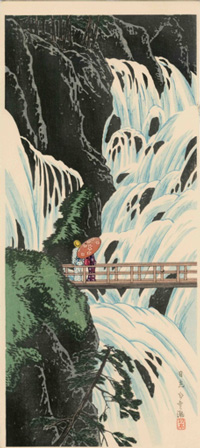
Takahashi Shōtei
“Nikkō Shirakumo-no-taki”
The beginning of Shōwa period
Shōzaburō got a smooth start on his business and started studies about old ukiyo-e to improve more. He organized “Ukiyo-e Kenkyū-kai” (means, a party of studying ukiyo-e) with Hujiwara Shizuya who was an assistant of Tokyo Teikoku Daigaku Bijutsu-shi Kenkyū Shitsu (Tokyo Teikoku University art history study room) and published a book of ukiyo-e “Mokuhan Ukiyo-e Taika Gashū” (means, a book of woodblock ukiyo-e masters) in 1915. Through the process of creating the book, he exchanged opinions with scholars, painters and artisans such as hori-shi or suri-shi. The book was highly regarded and sold out at once.
After getting two experiences, producing print for foreigners and studies of old ukiyo-e, Shōzaburō designed a new art of print “Shin-hanga” (means, new printing). “To create high quality prints, it is good to be done suri and hori by skilled artisans. Respect the will of the e-shi, incorporate new techniques abundantly and aim for expressions that have never existed. Have the perspective from overseas and success commercially.” His ideals were swelled out.
- The Birth of Shin-hangaOpen or Close
The production of Shin-hanga began with an Australian painter Fritz Capelari (1884~1950) who visited the shop of Watanabe often at that time. Watanabe tried various new techniques such as changing papers or doing a dare to make blurs by suri. On the occasion that suri-shi hesitated unprecedented techniques, Watanabe did suri sometimes.
Watanabe gained confidence in the techniques through the work productions of Capelari, asked Hashiguchi Goyō (1880~1921) to create prints and presented “Yokujō no Onna” as the first Shin-hanga by Japanese in 1915. Watanabe felt confident in the work but Hashiguchi couldn’t and this work got to be the only Shin-hanga that Hashiguchi created under Watanabe.
After that, Watanabe invited Itou Shinsui(1898-1972), Natori Shunsen(1886-1960), Yamamura Kōka(1885-1942), Tsuchiya Kōitu(1870-1949), Kawase Hasui(1883-1957) and Yoshida Hiroshi(1876-1950) who gained fame as a Western-style painter and released their art works one after another. He took a look at the works of various painters, picked up suitable works for Shin-hanga and negotiated with the artists directly. He also employed foreign painters such as Charles Bartlett(1860-1940) or Elizabeth Keith(1887-1956) and produced Shin-hanga that foreign landscapes were drawn on by their sketches.
Watanabe hold an exhibition "Shinsaku Hanga Tenrankai" (means, Exhibition of Newly-created Prints) at Nihonbashi, Tokyo in 1921. Many Shin-hanga were released all together and this exhibition got a lot of attention. This exhibition was picked up on not only Japanese but also foreign art magazines. The orders from Japan and foreign countries were increased and Watanabe expected that Taishō Shin-hanga is also be the art that represent Japan like Edo ukiyo-e.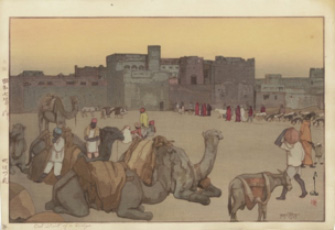
Yoshida Hiroshi
"Machi Hazure"
(means, outskirts of town)
Shōwa 7th (1932)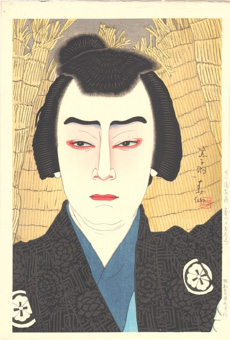
Natori Shunsen
"Ichikawa Ebizō Kinegawa no Yoemon"
(means, Yoemon at Kenegawa river by Ichikawa Ebizō, a kabuki actor)
Shōwa 26th (1951)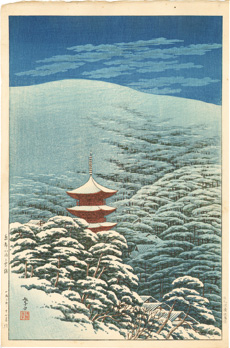
Ito Takashi
"Kyoto Yasaka no Yuki Sugata"
(means, snow sight of Kyoto Yasaka)
Shōwa 26th (1951)
- Beyond Kantō Dai Shinsai (Great Kantō Earthquake)Open or Close
Various han-moto (publishers) such as Baba Seizandō, Adachi Hanga Kenkyūjo or Takamizawa Mokuhansha started to release Shin-hanga and it seemed like that Shin-hanga had a bright future. But in 1923, Sept. 1st, a big earthquake attacked Kantō region in Japan. The shop of Watanabe got fired and all things such as art works, research materials or paints were burned down. He decided his markets on foreign countries and thought up to sale Christmas cards by Shin-hanga in America. This aim hit the target and after that, he became to create Christmas cards every year. As the results of these efforts, Shin-hanga started to get high valuation in foreign countries. There are some criticism that the Shin-hanga after the earthquake lost challenging or experimental minds and became monotony because of lack of materials or money. But there are Shin-hanga that express the atmosphere of the time such as the atmosphere of reconstruction or modernization or the hope and anxiety for changing cultures and customs vividly.
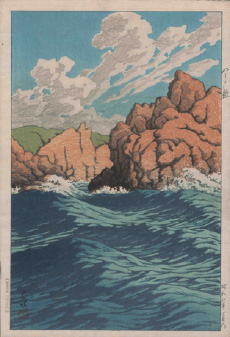
Kawase Hasui
"Hachinohe Same"
Shōwa 8th (1933)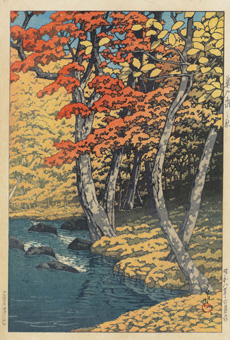
Kawase Hasui
"Oirase no Aki"
Shōwa 8th (1933)
Kawase Hasui started a trip to sketch various parts of Japan for 102 days from the next month of the big earthquake from the recommendation by Watanabe. From 1925, he started the series "Tokyo Nijukkei" that draw Tokyo after the earthquake. He also draw the landscapes where had nostalgic atmosphere or the flavor of old time and constructions that were newly born in various parts of Japan.
Watanabe started a publication business with Ohara Koson who was well known by kachō-ga (print/drawing of flowers, birds or living things except human being) from 1926. Kachō-ga was very popular because of its beauty that does not depend on countries and low price. From the latter part of the Meiji period, Ohara who was a Japanese style painter published woodblock prints from the publishers such as Akiyama Kokkeidō or Daikokuya Matuki Heikichi and got high valuation in foreign countries. There is a record that the kachō-ga by Ohara Koson were sold most at the 1st international woodblock print exhibition that hold at Warsaw, Poland in 1933.
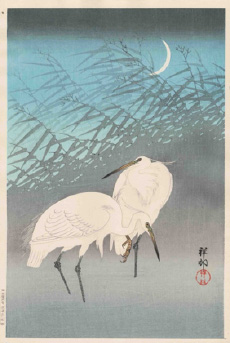
Ohara Shōson "Ashi ni Sagi"
Taishō 15th (1926)
- The End of Shin-hangaOpen or Close
Because of the outbreak of World War II, the circumstances surrounding Shin-hanga had changed completely. The biggest market America had been lost and some of the materials used in prints had been prohibited from being used because of wartime control. The e-shi and artisans were separated from each other because of evacuation or conscription.
The shop of Watanabe escaped the fires of war luckily and Watanabe released "Shinano Jukkei" with Itou Shinsui who evacuated to Nagano prefecture. In 1953, Shinsui created bijin-ga (print of beautiful women) and Hasui created hūkei-ga (landscape print) as a preservation project of woodblock prints by National Commission for Protection of Cultural Properties, the Ministry of Education, Science and Culture. Shin-hanga begun to be recognized as cultural assets by these country's movements.
But because of the aging of e-shi and other artisians and the death of Watanabe in 1962, the activities of creating Shin-hanga begun to be decreased and headed for the end gradually. After that, Shin-hanga was regarded as a souvenir for foreigners, not treated as an art work and the situation that the research about Shin-hanga had not proceeded lasted long. But in modern times, Shin-hanga has reexamined at foreign or local museums and in 2009, an exhibition about Shin-hanga in the Taishō period was hold at Edo Tokyo Museum. Many foreign celebrities collect the art works of Ito Shinsui, Kawase Hasui or Hashiguchi Goyō who created Shin-hanga by himself. And the artistry of Shin-hanga is being recognized in the whole world.
